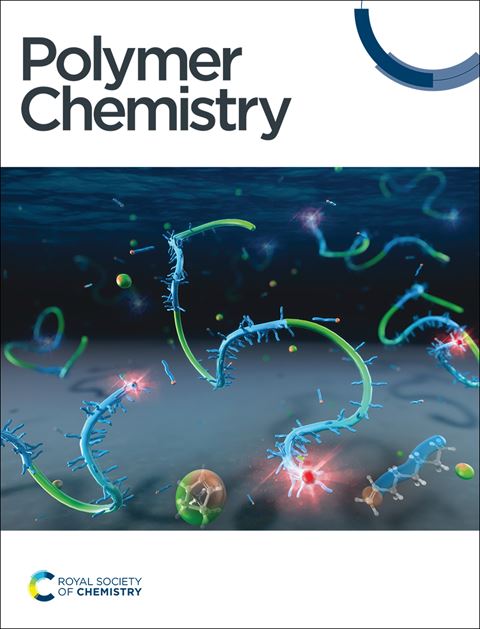Advanced Mechanical Properties of Amphiphilic Polymer Conetworks through Hierarchical Reinforcement with Peptides and Cellulose Nanocrystals
IF 4.1
2区 化学
Q2 POLYMER SCIENCE
引用次数: 0
Abstract
Amphiphilic polymer conetworks (APCNs) have been explored for various applications, including soft contact lenses, biomaterials, and membranes. They combine important properties of hydrogels and elastomers, including elasticity, transparency, and the capability to swell in water. Moreover, they also swell in organic solvents. However, their mechanical properties could be improved. We developed a two-level, bio-inspired, hierarchical reinforcement of APCNs using cellulose nanocrystals (CNCs) to reinforce peptide-reinforced APCNs formed from hydrophobic poly-β-benzyl-L-aspartate-block-polydimethylsiloxane-block-poly-β-benzyl-L-aspartate (PBLA-b-PDMS-b-PBLA) triblock copolymer crosslinkers and hydrophilic poly(2-hydroxy ethyl acrylate) (PHEA) chain segments. Bio-inspired peptide-polymer hybrids combine the structural hierarchy often found in natural materials with synthetic macromolecules, such as block copolymers with soft and hard segments, to enhance their mechanical properties. On the other hand, CNCs provide an additional means to dissipate mechanical energy in polymeric materials, thereby enhancing reinforcement. The key to homogeneously incorporating CNCs into the APCNs is the combination of hydrophobic CNCs (HCNCs) with peptide-blocks in the APCNs, exploiting the hydrogen bonding capability of the peptides to disperse the HCNCs. The effect of HCNCs on the ability of APCNs to swell in water and organic solvents, as well as on their thermal and mechanical properties, was characterized. Additionally, the nanostructure of the materials was analyzed via small-angle X-ray scattering (SAXS) and wide-angle X-ray scattering (WAXS). The swellability of the HCNC-containing APCNs was independent of the HCNC concentration, and all samples were highly transparent. The ideal HCNC concentration, in terms of maximal stress, strain, toughness, and reinforcement, was found to be between 6 and 15 wt%. An increase in Young´s modulus of up to 500% and toughness of up to 200% was achieved. The hierarchical reinforcement also greatly strengthened the APCNs when swollen in water or n-hexane. Thus, HCNCs and peptide segments can be used to reinforce APCNs and to tailor their properties.通过多肽和纤维素纳米晶体分层增强两亲性聚合物网络的先进力学性能
两亲性聚合物网络(APCNs)已被广泛应用于软性隐形眼镜、生物材料和膜等领域。它们结合了水凝胶和弹性体的重要特性,包括弹性、透明度和在水中膨胀的能力。此外,它们在有机溶剂中也会膨胀。然而,它们的机械性能可以得到改善。我们利用纤维素纳米晶体(CNCs)开发了一种两级仿生分层增强APCNs,以增强由疏水性聚β-苄基-l -天冬氨酸嵌段聚二甲基硅氧烷嵌段聚β-苄基-l -天冬氨酸(PBLA-b-PDMS-b-PBLA)三嵌段共聚物交联剂和亲水性聚(2-羟基丙烯酸乙酯)(PHEA)链段形成的肽增强APCNs。仿生多肽-聚合物杂合体将天然材料中的结构层次与合成大分子(如具有软段和硬段的嵌段共聚物)相结合,以增强其机械性能。另一方面,cnc提供了一种额外的手段来耗散聚合物材料中的机械能,从而增强增强。将疏水性碳纳米管(HCNCs)与APCNs中的肽块结合,利用肽的氢键能力分散碳纳米管,是将碳纳米管均匀整合到APCNs中的关键。表征了HCNCs对APCNs在水和有机溶剂中膨胀能力的影响,以及对其热性能和力学性能的影响。此外,通过小角x射线散射(SAXS)和广角x射线散射(WAXS)对材料的纳米结构进行了分析。含HCNC的APCNs的溶胀性与HCNC浓度无关,所有样品都具有高透明度。在最大应力、应变、韧性和强化方面,理想的HCNC浓度在6%到15%之间。杨氏模量提高了500%,韧性提高了200%。当APCNs在水或正己烷中膨胀时,分级强化也能显著增强APCNs。因此,HCNCs和肽段可用于增强APCNs并调整其特性。
本文章由计算机程序翻译,如有差异,请以英文原文为准。
求助全文
约1分钟内获得全文
求助全文
来源期刊

Polymer Chemistry
POLYMER SCIENCE-
CiteScore
8.60
自引率
8.70%
发文量
535
审稿时长
1.7 months
期刊介绍:
Polymer Chemistry welcomes submissions in all areas of polymer science that have a strong focus on macromolecular chemistry. Manuscripts may cover a broad range of fields, yet no direct application focus is required.
 求助内容:
求助内容: 应助结果提醒方式:
应助结果提醒方式:


